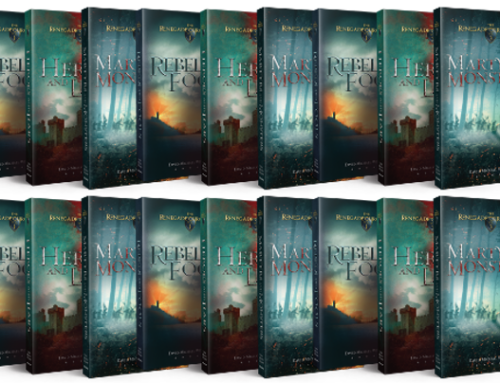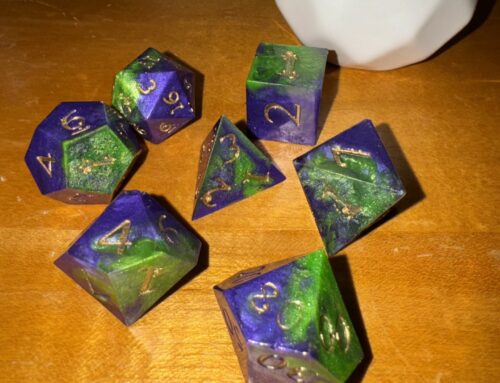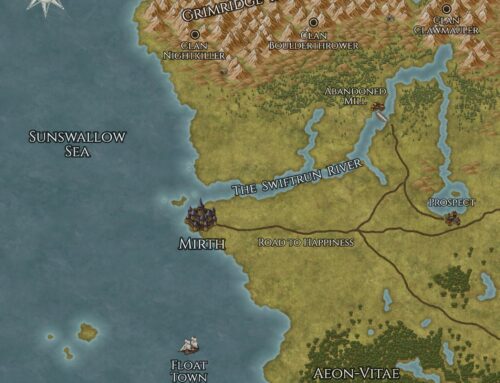If the gods are good, my next blog post will announce the availability of my next publication.
If not, December will have to do.
Meanwhile, here are the up-to-the-minute facts about The Curse of Er’Mah’Gerd!

Is The Curse of Er’Mah’Gerd a fantasy novel?
It’s fantasy, but no, it’s not a novel.
The Curse of Er’Mah’Gerd is a tabletop roleplaying game (TTRPG). Instead of reading the story from cover to cover, a gamemaster (GM) uses the book as a guide to lead players down whichever paths they pick.
TTRPGs are a little like the old Choose Your Own Adventure books but with multiple “readers” interacting in real time with one another and other characters that populate the stories. Therefore, The Curse of Er’Mah’Gerd is a form of shared storytelling.
The guidebook will be available in hardcover and digital editions.
What exactly is a tabletop roleplaying game?
Simply put, a tabletop roleplaying game—also called a pen-and-paper roleplaying game—is a form of storytelling in which the participants describe their characters’ actions through speech. Whether an attempted action succeeds often depends on the roll of one or more strange-shaped dice. Most TTRPGs include combat.
Some of the more popular fantasy TTRPGs include Dungeons & Dragons and Pathfinder. The Curse of Er’Mah’Gerd follows the Fifth Edition ruleset of the former.
Do I have to know how to play Dungeons & Dragons to play The Curse of Er’Mah’Gerd?
The person leading the game—the GM—will need to know the basics of Fifth Edition D&D. Players will benefit from knowing the 5E rules as well; however, they can learn as they go if they have a patient GM.
While games that use 5E rules benefit from an open license, the rules themselves do not. Therefore, I can’t include all of the instructions in my game. Fortunately, the basic rules are available for free here: http://media.wizards.com/2016/downloads/DND/SRD-OGL_V5.1.pdf.
I designed The Curse of Er’Mah’Gerd to be an entry-level adventure, avoiding some of the more nuanced mechanics and complexities that might confuse novice players.
Why did you decide to create a TTRPG?
After decades of writing short stories, novels, and fiction series, I wanted to try my hand at a different type of narrative: interactive storytelling.
While writing for a video game has long lingered on my bucket list, I don’t yet have the resources and skills to build even a basic game on my own. So that dream has been on hold for a bit.
Meanwhile, I have delved into Dungeons & Dragons as player over the past few years, even writing and running a few homebrew adventures of my own. Writing and publishing a TTRPG for people beyond my immediate family and friend groups seemed like a good way to take my talents to the next level and develop skills—such as technical writing, managing branching narratives, and playtesting—for future projects.
Most importantly, making my own game from scratch sounded like a whole lot of fun—never underestimate the Rule of Cool!
Is this your first tabletop roleplaying game?
The Curse of Er’Mah’Gerd is my first published TTRPG.
Prior to that, I wrote and then ran a couple of homebrew games—short adventures designed to be one-shots that inevitably spilled into additional sessions.
The first game was a sequel to a third-party module I had run earlier. I had spent so much time developing the setting and nonplayer characters (NPCs) that it seemed worthwhile to bring the heroes back for another mystery. My second homebrew adventure built on the backstory of one of my own player characters (PCs). The other PCs had to rescue their missing ally. In both cases, I probably spent too much time on the worldbuilding and mapping out myriad story paths for so short an adventure. Live and learn!
I’ve also contributed freelance writing and editing to a few 5E adventures and resources for Goodman Games, a prestigious TTRPG publisher.
What is The Curse of Er’mah’Gerd about?
I like to describe the game as a lighthearted, self-contained adventure for fans of the fantasy genre—especially those who want to have a little fun with fantasy tropes.
The back-cover blurb sheds some light on the story itself:
NO GOOD DEED GOES UNPUNISHED
When Good Company ventured into the Funk a year ago to retrieve the fabled Staff of Er’Mah’Gerd, the heroes hoped to bring prosperity to a land long fraught with peril.
But even as the ancient curse seems to fade, three factions fight for control over the region. The feral elves of the Untamed North suffer no trespassers in the former no-man’s land, while the industrious dwarves of the Civilized South seek to expand their borders. Meanwhile, the masked humans of the Disorient keep their movements—and motivations—a mystery for now.
With a threefold war brewing, Sir Larpsalot, Elvish Presley, and the rest of Good Company must return to the Forbidden Frontier to mediate what might prove to be the shortest peace talks in history.
To accommodate a variety of player preferences, three types of challenges are emphasized throughout the game: combat, diplomacy, and puzzle solving. Each of the heroes that make up Good Company is better suited for some of those aspects than others.
What does the title mean?
The Staff of Er’Mah’Gerd was introduced in The Lost Tale of Sir Larpsalot, a YA fantasy novel I wrote and published in 2020. The name of that magical weapon always got a laugh, so I thought I’d somehow work it into the title to immediately imply the humorous tone of the game.
What’s more intriguing than a strange staff? How about a curse? Only after I decided on The Curse of Er’Mah’Gerd for a title did I realize I also was subconsciously riffing on a classic D&D module, Curse of Strahd.
Why did you tie the game to The Lost Tale of Sir Larpsalot’s characters and setting?
The Lost Tale of Sir Larpsalot is about a group of teens who dress up as fantasy heroes to act out battles in their fictional realm of Mezzo-Earth. However, the book is a portal fantasy, and the protagonists are ultimately deposited into a different fantasy world.
While the teens adopt their avatar personas throughout the novel, the reader gets only glimpses of Mezzo-Earth. I always felt that was kind of a shame because there were so many more irreverent and punny tropes to exploit!
At the same time, I wanted to create a game that wasn’t overly complex, one that could appeal to gamers of all ages, including teens and other newcomers to TTRPGs. I realized I already had all the ingredients right in front of me. So, perhaps counterintuitively, a novel about live-action roleplaying (LARPing) made for the perfect tabletop roleplaying game.
Do I have to read The Lost Tale of Sir Larpsalot to enjoy The Curse of Er’Mah’Gerd?
No, the novel isn’t required reading.
The Lost Tale of Sir Larpsalot introduces five of the six playable characters (PCs) available in The Curse of Er’Mah’Gerd, and many other details from the novel found their way into the game—including spells like Torchnado and Psychlone as well as magical weapons like Excaliburnt and the Cloak of Shadowbright. So folks who have read The Lost Tale of Sir Larpsalot will recognize these and will perhaps have a better sense of who the PCs are right off the bat.
However, players are encouraged to give the heroes of Good Company their own personal twists. In short, anyone can enter Mezzo-Earth without any prior knowledge of the setting and characters and still have a good time!
Who is the audience for the game?
I aimed to engage players 13 and older.
Because The Curse of Er’Mah’Gerd adheres to the robust Fifth Edition ruleset, I took steps to streamline the adventure in order to accommodate new and/or rusty players, including first-time gamemasters (GMs) and younger players. It may also appeal to longtime TTRPG gamers who want to try something a little irreverent and, at times, silly.
From the outset, my goal was to make a game that was perfect for parents—or aunts or uncles or whatever—who want to introduce D&D to the teens or other adults in their lives.
What is the game “rated”?
As written, The Curse of Er’Mah’Gerd would probably earn a PG or PG-13 rating due to violence as well as references to alcohol. Of course, individual GMs can make whatever changes they see fit to make in-game content more or less mature in nature.
How many people can play The Curse of Er’Mah’Gerd?
The game can be enjoyed by as few as two people—the GM and a single player—or a GM and up to six players.
What is all included with The Curse of Er’Mah’Gerd?
Both the hardcover and digital editions include the following:
- 1 complete adventure that can be played through multiple times
- 6 pre-generated player characters with unique classes and abilities
- 9 new deities that can be used in nearly any setting
- 13 maps
- 13 optional encounters
- 16 new creature and NPC stats
- 22 unique items
- 30 original spells
What makes The Curse of Er’Mah’Gerd different from other RPGs?
First and foremost, the game doesn’t take itself too seriously. How could it when you have characters named Elvish Presley and Lord Grimdark?
Secondly, I designed the game to be as self-contained and streamlined as possible so that new GMs and players could rely mostly on the book for guidance, rather than needing a library of additional sourcebooks.
The Curse of Er’Mah’Gerd is also very scalable. For example, there aren’t a lot of TTRPGs that allow a GM to run the game for as few as one player or as many as six. There are also more than a dozen optional encounters, which lets the GM adjust the pacing of the adventure and cherry pick what seems most rewarding for that particular group of players.
Finally, the adventure encourages multiple playthroughs, unlike many one-and-done TTRPGs. Subsequent playthroughs allow players to try out different heroes, choose different allies, battle new foes, and experience unexplored encounters.
Who exactly is Lord Grimdark?
Playing TTRPGs with larger groups seems to be the trend lately. I wanted to make my game accessible to as many as six players, but there were only five core members of Good Company in The Lost Tale of Sir Larpsalot: Sir Larpsalot, Elvish Presley, Brutus the Bullheaded, Master Prospero, and Tom Foolery.
Excited at the prospect of augmenting the team, I came up with a new antihero: Lord Grimdark, an edgelord who serves as a counterpoint to righteous Sir Larpsalot and adds new dynamics (and dysfunction) to the motley band of heroes.
I mean, who wouldn’t want to play as an emo half-elf wielding a sword named Angstbringer?
Can I create my own player characters for the game?
The Curse of Er’Mah’Gerd includes six pre-generated heroes. Choosing from these fully formed PCs helps everyone get to the adventure more quickly and ensures balanced gameplay.
The pre-rolled Good Company heroes have skills and equipment specifically designed for this adventure. Frankly, DIY characters will find themselves at a disadvantage, since the Good Company heroes are slightly above average in might for their levels. For these reasons, rolling new characters is not advised.
Having said that, players are encouraged to make cosmetic customizations to the six provided PCs. Go ahead and change their names, genders, backstories. As long as the PCs retain their original races and classes, they will remain a good fit for the game.
What was your biggest challenge while making The Curse of Er’Mah’Gerd?
Writing and publishing a novel is a complex process, but it’s a course I’ve learned to navigate well after all this time.
However, writing and publishing a TTRPG is even more complicated, thanks to the need for multiple story paths, a plethora of technical writing opportunities, playtesting, and other game-specific tasks. Even the book’s layout—filled with images and maps, tables, and multi-tiered subsections—required far more time to perfect than the typically single-column, text-dominant pages of a novel and, therefore, necessitated outsourcing to a professional.
Keeping all of those unfamiliar plates spinning while meeting my deadlines proved far more challenging than I had anticipated.
What was the biggest surprise?
How much fun playtesting would be!
Of course, I didn’t think playing my game would be unfun, but watching players develop their characters and interact with my NPCs and, better yet, with one another was a riot. Players will always surprise their GMs—that’s just the way it goes—but I really enjoyed seeing how differently my groups reacted to the same set of circumstances.
What I liked best about playtesting, however, was being able to experience these stories with my audience. Novel writing and reading both tend to be isolating activities. With my other books, I don’t get to peer over a reader’s shoulder and see where they laugh, gasp, or decide to take a break. When GMing my adventure, however, I was able to witness every single reaction—and add to the story in real time when the players inevitably threw me a curveball.
Do you plan to make more tabletop roleplaying games?
I’m not gonna lie: The Curse of Er’Mah’Gerd took a lot out of me. Even for a modest-sized campaign, the scalable nature of the game required a lot of time for writing, testing, and tweaking. The game monopolized most of my attention for a year and a half—and that’s not counting the off-and-on-again brainstorming leading up to the project.
And, honestly, I’m eager to write another novel!
At the same time, I’m fortunate to have a few freelance TTRPG projects in the pipeline, including writing a one-shot for Goodman Games’ Fifth Edition Fantasy series. In all likelihood, that won’t see the light of day until later in 2023 or possibly even 2024.
Have you written any other blog posts about The Curse of Er’Mah’Gerd?
I sure did, and here they are:



Leave a comment